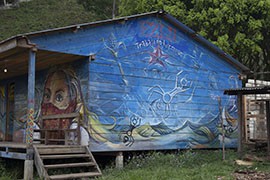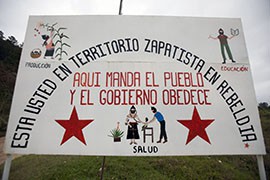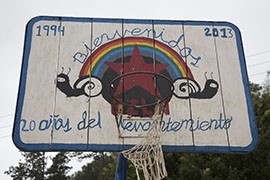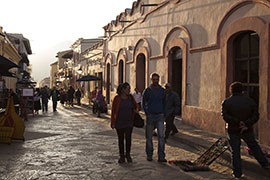Cronkite News has moved to a new home at cronkitenews.azpbs.org. Use this site to search archives from 2011 to May 2015. You can search the new site for current stories.
Zapatista revolution moves slowly at home, but global appeal endures
SAN CRISTOBAL DE LAS CASAS, Chiapas, Mexico – Their everyday presence is almost unnoticeable in this picturesque tourist destination they took over in an armed revolution 20 years ago.
But the Zapatista movement endures quietly, nonviolently and defiantly outside of the big city in five zones they call “caracoles” – snails – symbolic of a desire to move slowly in the face of technological change and globalization.
“We’re thinking of our future, of our kids,” said a member of Caracol Morelia’s nine-person Council of Good Governance that collectively makes decisions for the communities they serve. “They say we lack development, but we have our own way – walking forward.”
The concept of walking forward slowly, step by step, is one of the Zapatistas’ main tenets. Things take time. They’re willing to wait.
More than 70 percent of Chiapas’ residents still live in poverty, according to Mexico’s National Council for the Evaluation of Social Development Policy, and nearly 40 percent of the state’s indigenous people cannot read or write, according to the International Service for Peace, a Chiapas-based nonprofit. Those figures haven’t changed much since the revolution started on Jan. 1, 1994.
The Zapatistas may not have achieved many of the lofty separatist goals they had when they rebelled against the Mexican government, although they do operate autonomous governments and schools. But they have prevailed where other revolutionary movements have failed, surviving and thriving as an iconic symbol of left-leaning activists throughout the world.
“They have succeeded in not being killed and not being targeted for elimination, and they have found some kind of a peace with the Mexican state,” said David Shirk, a global fellow for the Mexico Institute at the Woodrow Wilson International Center for Scholars, a Washington, D.C.-based global policy and research think tank. “They have been able to hold their ground. They wouldn’t be able to do it without the tremendous visibility they achieved early on.”
A large part of that visibility was due to the Zapatista’s iconoclastic leader, a pipe-puffing, black ski-mask-clad intellectual known as Subcomandante Marcos. On May 25, 2014, Marcos emerged from seclusion to announce that he was stepping down as the movement’s spokesman.
But in typical enigmatic style, he also said he was taking a new nom de guerre, Subcomandante Galeano, in honor of a Zapatista activist killed in the latest of sporadic attacks by paramilitary groups.
The activist, Jose Luis Solis Lopez, a teacher at a Zapatista school who had called himself Galeano, was slain May 2 after members of paramilitary groups attacked him and others at Caracol La Realidad, according to La Jornada, the Mexico City newspaper. They reportedly ambushed three vehicles that Zapatistas were traveling in, injuring at least 13 others.
“We think that one of us must die so that Galeano can live. So death does not take a life but a name,” Marcos said in a communique broadcast on Radio Zapatista – leading some to speculate he may continue a leadership role but under a new name.
The Chiapas government said it would investigate the killing, the result of rising tensions over whether to allow government benefits into their communities, according to La Jornada. The Zapatistas generally have shunned accepting government resources.
The networked revolution
Messages about the attack spread through Zapatista support networks and sympathizers around the world, much like they did during the group’s early days. Zapatistas have used cell phones and the Internet to connect with groups like Occupy Wall Street and Chicago’s Mexico Solidarity Network. Sympathizers still come from Europe and the U.S. to help, observe and work in Zapatista communities.
And beginning last year, the Zapatistas opened their communities and their homes to supporters with a series of “escuelitas,” or little schools, to teach their way of life in hopes of continuing to spread their philosophy and build their network of support.
To many Zapatista supporters, the revolutionary movement is almost a classic David vs. Goliath story. If the Mexican government were to start terrorizing the Zapatistas now, Shirk said, it would be a public-relations nightmare.
“The Zapatistas probably have more supporters outside of Mexico than they do inside of Mexico,” Shirk said. “They had a much broader resonance outside of Mexico in part because they were tapping into issues of social justice or social injustice that are much more broadly observable and widespread in basically every country.”
That idea, that injustice is alive and well across the world, rang true with Occupy Wall Street organizer and activist Justin Wedes. He attended an escuelita in December in Caracol Morelia because he sensed that the Occupy movement had some lessons to learn from the Zapatistas.
“We’re in the same place as the Zapatistas were in their uprising,” Wedes said. “We’ve been forgotten, we’ve been left behind, we’ve been ignored and trivialized. We have to make our own world.”
Wedes spent his days in Morelia reading Zapatista textbooks about autonomy and a culture of resistance, visiting collectives where people baked bread or cleared forest for livestock, and sharing meals and ideas with his hosts in one of the pueblos outside the central compound.
“I was always asking political questions about the movement and the history and the future and the Mexican government and the principles of the movement,” he said. “The people were just very warm. Once you got to know them and they trusted you, they would open up to you.”
The road to the escuelitas
When the North American Free Trade Agreement was signed by Canada, the U.S. and Mexico, it brought a promise of propelling Mexico into the First World, but it was the last straw for the indigenous people of Chiapas. Fearful they would lose their traditional way of life and wanting their voices to be heard, the Zapatista Army of National Liberation rebelled on New Year’s Day 1994.
They called themselves “Zapatistas” after early-20th-century revolutionary leader Emiliano Zapata, the founder of Mexico’s agrarian-reform movement, who sought to reclaim land and give it back to the people who worked it. This idea echoes on the walls of the caracoles, in murals depicting Zapatista history and beliefs: “La tierra es de quien la trabaja” – the land belongs to those who work it.
More than 2,000 mostly indigenous soldiers, both armed and unarmed, stormed the city of San Cristobal with a declaration of war, known as the First Declaration of the Lacandon Jungle. The document included a short statement to the people of Mexico, explaining that the war was not only a last resort, but a just decision.
While key leaders were college-educated and media-savvy like Subcomandante Marcos – who has been identified by the Mexican government as Rafael Guillen Vicente, a former professor – the soldiers were mostly disenfranchised descendants of Mayan tribes who historically had been ignored by the state and federal governments.
Twelve days after the uprising, the Mexican government and the Zapatistas declared a ceasefire. The fighting had resulted in at least 145 deaths and sparked the interest of human-rights organizations from around the world.
The Zapatista revolution, from the outside, looks like a series of ebbs and flows, opening and closing their society from the world at large. Since 2001, the Zapatistas have remained peaceful and relatively silent in the eyes of most. But they haven’t stopped evolving. In August 2003, they formed the Councils of Good Governance as an experiment in self-government.
Another period of silence ended in 2005 with “La Sexta” – the Sixth Declaration of the Lacandon Jungle. The 12-page document expressed the need for a new constitution and way of doing politics. It also outlined a way for foreigners to show support and get involved, a crucial piece of the movement’s opening up to the world.
“And we want to tell the brothers and sisters of Social Europe, that which is dignified and rebel, that you are not alone,” La Sexta stated. “That your great movements against the neoliberal wars bring us joy. That we are attentively watching your forms of organization and your methods of struggle so that we can perhaps learn something.”
From tourist center to revolution base
Although there hasn’t been a large-scale violent struggle for more than a decade, nearly one-third of the Mexican Army is currently stationed in Chiapas, according to Global Exchange, an international human-rights organization.
Convoys of camouflaged soldiers with AK-47s can be seen driving to and from Caracol Morelia. On the winding roads through the mountains, army bases dot the landscape as reminders of the area’s contentious history.
Zapatista families live in indigenous communities in concert with people who aren’t necessarily aligned with their cause. On a bumpy dirt road to Caracol Morelia’s government center, kids play soccer on a basketball field, women wash clothes in a stream and a donkey stops in the middle of the road.
A blue gate, manned by two men and a toddler, keeps visitors from entering the government center without the permission of the Council of Good Governance. A mural of a Zapatista woman overlooks the gate, one of many adorning building walls in the compound.
The murals, the work of local artists and foreign visitors on leftist pilgrimages, depict the sentiments of the movement: Zapatistas arm-in-arm with foreign visitors; an ant with the saying “trabajo de hormigas,” – the work of ants; a satellite and a computer to show the group’s connections to the outside world. They’re on the walls of the autonomous community’s school, auditorium, cafeteria, clinic – even the basketball backboards.
The Council of Good Governance agreed to answer questions collectively and diplomatically, spending hours deliberating on how to respond and who would answer each question. Despite the common depiction of Zapatistas in popular culture, the men and women of the council did not wear their signature black ski masks.
Their meeting room, tucked in back of the compound next to the auditorium and the basketball court, had two large wooden desks for the council behind a heavy metal door. A mural showed Zapata holding two flags – one for the Zapatistas and one for Mexico. He stands in front of a picturesque waterfall, similar to ones that can be seen on the drive to Morelia, holding a gun, some ammo and a machete.
“We’re different. How are we going to wait for the government?” one council member said of the way the community functions now. “We have our autonomy…. There’s always problems, but there’s always solutions.”
In order to maintain their autonomy, the group welcomes human-rights observers from the Fray Bartolome de las Casas Human Rights Center – or Frayba – into the caracoles to make sure the government and paramilitary groups don’t encroach on the lives they’ve built for themselves. They break bread with visitors, often a traditional lunch of “atole,” a masa-based hot corn drink, and teach them about their history and struggle.
“In collectivism, everyone shares with companeros,” a council member said. “There are a lot of people who visit, and we hope to share with them.”
With the escuelitas, that openness rose to another level – the visitors each had a host who opened their own home, even here in Morelia, the most remote of the caracoles.
“Everyone is excited and happy that people want to learn more about our fight and our lives and collectivism,” a council member said.
Zapatistas as inspiration
Julius Martin-Humpert isn’t always impressed with the “Zapatourists” who come through San Cristobal in search of the revolution without knowing the history or reading up on the ideas.
“It’s like, ‘Oh look at the murals! Oh look at the masks!’” said the 21-year-old German traveler. “A lot of left-wing activists are like, ‘Oh the revolution is happening here! Let’s take a photo!’”
Martin-Humpert, on the other hand, can recommend a list of books and musicians who exemplify the movement.
“Chiapas and the Zapatista movement was like a role model for us – reorganization of the communities, the dignity of the culture and the language, education, everything, the whole complete system of autonomy,” said Martin-Humpert, who traveled to Chiapas after spending a year working with immigration and indigenous issues in Buenos Aires, Argentina.
He now works in the lobby of a San Cristobal hostel and does human-rights work in his spare time with Frayba in Zapatista communities. He said he plans on taking what he has learned from the Zapatistas back home to Germany, where he is optimistic that the world can change from its current consumer state.
“We have to fight from our contexts,” Martin-Humpert said. “We have to gain consciousness and knowledge, and that’s a great place to gain and learn a lot. But we have to take this to our place, to our context, to our lives, to our societies and change it from there.”
Other human-rights supporters were not as optimistic about the Zapatista message as a catalyst for change. Marco Cavinato, a 24-year-old university graduate, said he isn’t so sure he wants to go back to Italy to fight for change.
“It’s not that easy to work in a way that is really influencing something in Europe,” Cavinato said. “If you don’t have a job that has a real influence in a bigger context, I don’t know how useful it can be to work from the First World.”
Back in the ‘First World’
Claire Flanagan first came to Chiapas as a student in a study-abroad program with Mexico Solidarity Network, a social-justice organization based in Chicago. She said she came back from Chiapas with a deeper understanding of struggle and an understanding that the movement is connecting people from many different backgrounds and geographical areas.
“It’s a global struggle against globalization, against the expansion of neo-liberalism, against capitalism, and the struggle is different in every place, but it is also so much connected,” Flanagan said.
Since returning to the U.S., Flanagan said she has focused on community outreach and immigrants’ rights. She’s not program coordinator for Portland Central America Solidarity Committee, a group that works for human rights throughout the Americas.
“I think what drew me to immigrants’ rights work was recognizing that one important part of building movements is working across these lines that are used to divide people,” Flanagan said. “Working with people towards immigrants’ rights is sort of a way of bridging relationships across difference and connecting different struggles in a lot of ways.”
Flanagan isn’t the only one who is using the knowledge she gained from the Zapatistas to bridge relationships and connect with the community.
Wedes, the Occupy organizer, said he’s transitioning from that movement to starting a grass-roots, independent political party in Oregon. He sees borders, both mental and physical, opening up as young people travel more and are increasingly connected by the Internet.
“You can build the new within the shell of the old,” Wedes said. “This opens up a space for us as visionaries, as activists, as people who are conscious of society needing to reshape itself. It offers us an opening … to envision a new kind of world. And the Zapatistas have laid out a model for that.”
Moving forward, at ‘caracol’ pace
This year marks the 20th anniversary of the Zapatista uprising. While it has new, younger leaders, the ideas that inspired the movement in 1994 – reclaiming the land, finding autonomy, educating from within -?still ring true to them.
“I am you and you are me and we are all Marcos,” one Council of Good Governance member said, echoing a long-held Zapatista belief that no one person is more important than another. “That’s the idea.”
Shirk said the Zapatistas should seize on seize on the significance of the anniversary to elicit more support.
“This is the 20-year mark,” he said. “They have not really taken advantage of that … In my view, it seems like they seem somewhat rudderless – where are they going, what are they headed to, what’s their future. It’s not clear to me, and it’s not even clear to them, I don’t think.”
But the Zapatistas’ legacy is clear to Martin-Humpert, the German activist. He sees it as an example of growing interconnectedness, of the world shrinking and of views expanding among the young.
“I think we live in a world where a lot of young people get to know a lot, where you travel all over the world, you can go to Chiapas, you can go to India,” he said. “I think we have to take advantage of all this possibility and the mass of consciousness and knowledge we can achieve.”













